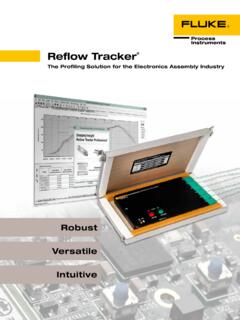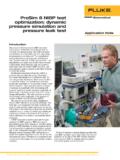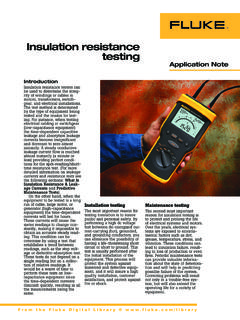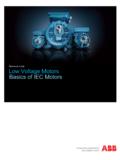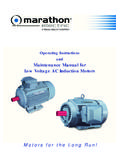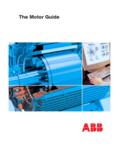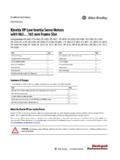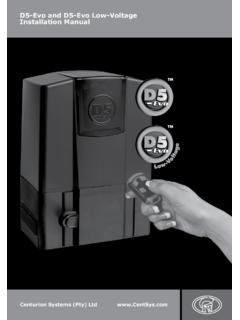Transcription of Single-phase motors - Fluke Corporation
1 Application NoteMost problems with 1 motorsinvolve the centrifugal switch,thermal switch, or capacitor(s). Ifthe problem is in the centrifugalswitch, thermal switch, or capac-itor, the motor is usually servicedand repaired. However, if themotor is more than 10 years oldand less than 1 HP, the motor isusually replaced. If the motor isless than 1/8 HP, it is almostalways split-phase motorsThe split-phase motor has astarting and running starting winding is automat-ically removed by a centrifugalswitch as the motor split-phase motors alsoinclude a thermal switch thatautomatically turns the motorOFF when it overheats. Thermalswitches may have a manualreset or automatic reset. Cautionshould be taken with any motorthat has an automatic reset, asthe motor can automaticallyrestart at any time. See Figure troubleshoot a split-phasemotor, apply the following procedure:1. Turn power to motor inspect the the motor if it isburned, the shaft is jammed,or if there is any sign of Check to determine if themotor is controlled by a ther-mal switch.
2 If the thermalSingle-phase motorsFrom the Fluke Digital Library @ is manual, reset thethermal switch and turnmotor If the motor does not start,use a voltmeter to check forvoltage at the motor termi-nals. The voltage should bewithin 10 % of the motor slisted voltage. If the voltage isnot correct, troubleshoot thecircuit leading to the motor . Ifthe voltage is correct, turnpower to motor OFF so themotor can be Turn the handle of the safetyswitch or combination starterOFF. Lock out and tag thestarting mechanism per company CHECK MOTORIF BURNED, SHAFTREPLACE MOTORT1T4T2T3IS JAMMED, ORDAMAGE IS SEENRESETMANUAL RESETTHERMALMOTOR TERMINALSCHECK VOLTAGE ATTURN OFF ANDLOCK OUT POWERSWITCHCHECK CENTRIFUGAL SWITCHT3T2T4T1 SWITCHSAFETYNCNC HELD OPENTAKE RESISTANCEWITH POWER OFFREADINGSOR ZERO READINGREPLACE motor IFINFINITY READINGGOOD SWITCH = 0 BAD SWITCH = INFINITYGOOD SWITCH = INFINITYBAD SWITCH = 0 TROUBLESHOOTING SPLIT-PHASE MOTORSF igure 1.
3 Troubleshoot split-phase motors with an Corporation Single-phase power OFF, connect theohmmeter to the same motorterminals the incoming powerleads were disconnectedfrom. The ohmmeter will readthe resistance of the startingand running windings. Sincethe windings are in parallel,their combined resistance isless than the resistance ofeither winding alone. If themeter reads zero, a short ispresent. If the meter readsinfinity, an open circuit ispresent. In either case the motor should be inspect the centrifu-gal switch for signs of burn-ing or broken springs. If anyobvious signs of problems arepresent, service or replace theswitch. If not, check theswitch using an operate the centrifugalswitch. (The endbell on theswitch side may have to beremoved.) If the motor is good,the resistance on the ohmmeterwill decrease. If the resistancedoes not change, a problemexists.
4 Continue checking todetermine the capacitor motorsA capacitor motor is a split-phasemotor with the addition of one ortwo capacitors. Capacitors givethe motor more starting and/orrunning torque. Troubleshootingcapacitor motors is similar totroubleshooting split-phasemotors. The only additionaldevice to be considered is have a limited lifeand are often the problem incapacitor motors . Capacitors mayhave a short circuit, an open cir-cuit, or may deteriorate to thepoint that they must be can also changethe value of a capacitor, whichcan cause additional a capacitor short-circuits,the winding in the motor mayburn out. When a capacitor dete-riorates or opens, the motor haspoor starting torque. Poor startingtorque may prevent the motorfrom starting, which will usuallytrip the capacitors are made with two conducting surfacesseparated by dielectric material is a medium inwhich an electric field is main-tained with little or no outsideenergy supply.
5 It is the type ofmaterial used to insulate con-ducting surfaces of a are either oil or elec-trolytic. Oil capacitors are filledwith oil and sealed in a metalcontainer. The oil serves as thedielectric motors use electrolyticcapacitors than oil capacitors are formedby winding two sheets of alu-minum foil separated by piecesof thin paper impregnated withan electrolyte. An electrolyte is aconducting medium in which thecurrent flow occurs by ion migra-tion. The electrolyte is used asthe dielectric material. The alu-minum foil and electrolyte areencased in a cardboard or alu-minum cover. A vent hole is pro-vided to prevent a possibleexplosion in the event the capac-itor is shorted or capacitors are used withcapacitor motors . Capacitors thatare designed to be connected toAC have no polarity. See Figure OFF AND LOCK OUT POWER POWER IS OFFCHECK TO MAKE SURESWITCHSAFETY20 k , 5 WRESISTORREMOVE CAPACITOR COVERAND CAPACITORSIGNS OF DAMAGEVISUALLY CHECK FORREMOVE ANDDISCHARGE CAPACITORTROUBLESHOOTING CAPACITOR MOTORSSET YOUR VOLTMETER TO MEASURE CAPACITANCE.
6 THE CAPACITANCE VALUE READ SHOULD BE WITHIN +/- 20% OF THE VALUE ON THE CAPACITOR LABELF igure 2. Troubleshoot capacitors with an ohmmeter and a Corporation Single-phase motorsTo troubleshoot a capacitormotor, apply the following procedure: the handle of the safetyswitch or combination starterOFF. Lock out and tag thestarting mechanism per com-pany a voltmeter, measurethe voltage at the motor ter-minals to make sure thepower is are located on theoutside frame of the the cover of theTroubleshooting Guide continued on next pageTroubleshooting Guide for Single-phase MotorsProblemPossible CauseSuggested Test ToolCorrective ActionMotor will not startThermal cutout Reset the thermal switch. Caution: Resetting the thermal switch may automatically start the switch is fuse or Basic electrical tester,Test the OCPD. If voltage is present at the input, but not the output of the OCPD, the fuse isopen CBDMM , clamp meter, blown or the CB is open.
7 Check the rating of the OCPD. It should be at least 125 % of theor Megohmmetermotor s FLC. motor overload on Allow overloads to cool. Reset overloads. If reset overloads do not start the motor , starter trippedtest the starter. Low or no voltageBasic electrical tester,Check the voltage at the motor terminals. The voltage must be present and within 10 % of theapplied to motor DMM or clamp metermotor nameplate voltage. If voltage is present at the motor but the motor is not operating, remove the motor from the load the motor is driving. Reapply power to the motor . If the motor runs, the problem is with the load. If the motor does not run, the problem is with the motor . Replace or service the motor . Open control circuitBasic electrical tester,Check for cleanliness, tightness, and breaks. Test the circuit starting with the incoming powerbetween incoming DMM or clamp meterand moving to the motor terminals.
8 Voltage generally stops at the problem and motorStarting winding notBasic electrical tester,Check the centrifugal switch to make sure it connects the starting winding when the motorreceiving powerDMM or clamp meteris , CB, or overloadsBlown fuse or openBasic electrical tester,Test the OCPD. If voltage is present at the input, but not the output of the OCPD, the fuse isretrip after serviceCBDMM , clamp meter,blown or the CB is open. Check the rating of the OCPD. It should be at least 125 % of theor Megohmmetermotor s overload on Allow overloads to cool. Reset overloads. If reset overloads do not start the motor , starter trippedtest the starter. Low or no voltage Basic electrical tester,Check the voltage at the motor terminals. The voltage must be present and within 10 % of theapplied to motorDMM or clamp metermotor nameplate voltage. If voltage is present at the motor but the motor is not operating, remove the motor from the load the motor is driving.
9 Reapply power to the motor . If the motor runs, the problem is with the load. If the motor does not run, the problem is with the motor . Replace or service the motor . Open control circuit Basic electrical tester,Check for cleanliness, tightness, and breaks. Test the circuit starting with the incoming powerbetween incoming DMM or clamp meterand moving to the motor terminals. Voltage generally stops at the problem and motorMotor shaft does Disconnect the motor from the load. If the motor shaft still does not turn, the bearings arenot turnfrozen. Replace or service the producesBroken orConnect or replace ground strap. Test for proper shockdisconnectedground strap Hot power lead atDisconnect the motor . Open the motor terminal box and check for poor connections, damagedmotor connectinginsulation, or leads touching the frame. Service and test motor for is touching motor frame motor windingRemove, service, and test to framecapacitor.
10 Caution: A goodcapacitor will hold a charge,even when power check the capacitorfor leakage, cracks, or the capacitor if the capacitor fromthe circuit and discharge it. Tosafely discharge a capacitor,place a 20,000 , 2 W resis-tor across the terminals forfive After the capacitor is dis-charged, connect the ohmme-ter leads to the capacitorterminals. The ohmmeter willindicate the general conditionof the capacitor. A capacitor iseither good, shorted, or your voltmeter to measurecapacitance. The capacitancevalue read should be within 20 % of the value on thecapacitor Corporation Single-phase motorsThis article is based on materialexcerpted from Electric MotorDrive Installation and Trou-bleshooting, TroubleshootingElectric/Electronic Systems,2nd Edition, Power Quality Measurement andTroubleshooting, and Electrical motor Controls,2nd Edition published by American TechnicalPublishers, Inc.




